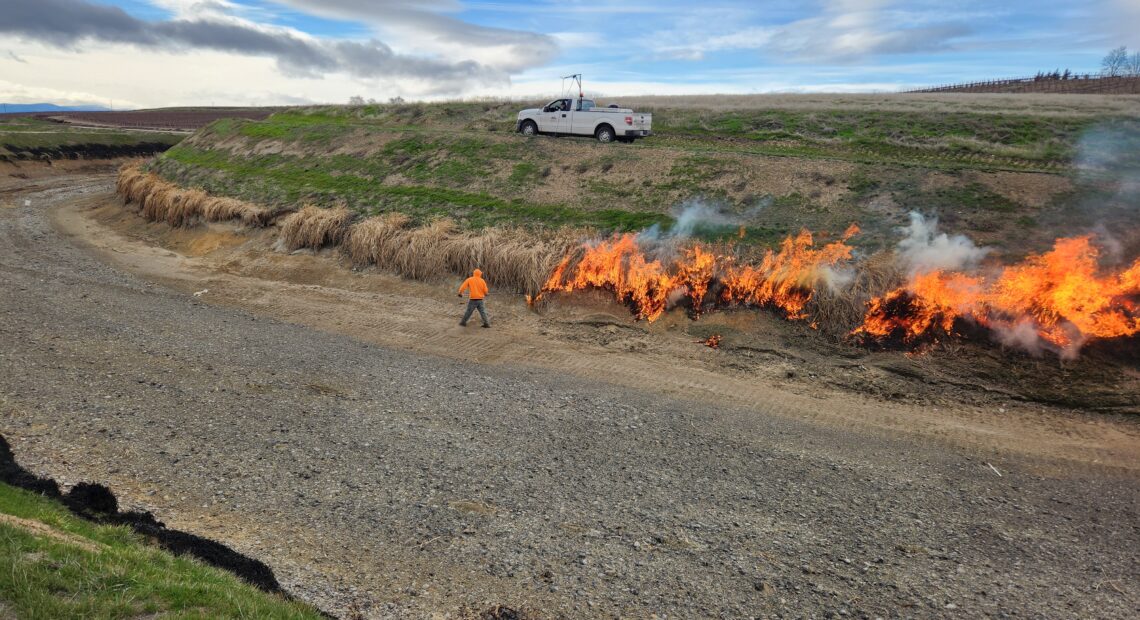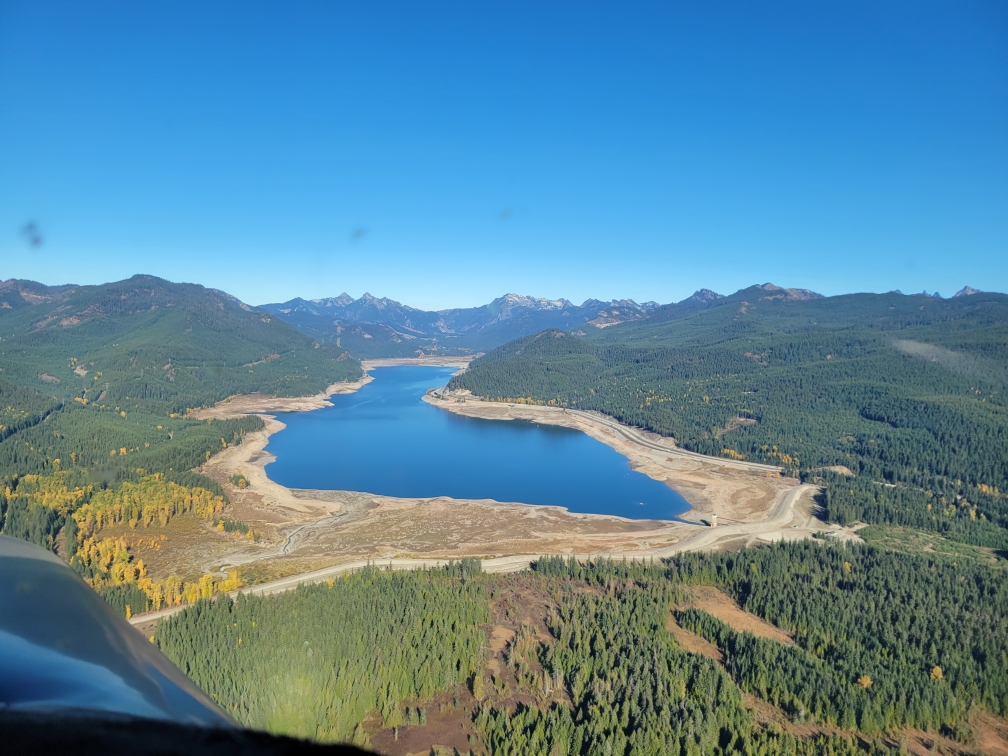
As the Northwest turns toward Spring, agricultural irrigators, fire managers and water experts watch the sky
Listen
(Runtime 1:00)
Read
A story in plot points: a federal map tracking the latest snowpack shows Oregon awash with royal blue, turquoise and green dots. In Washington state there are many yellow dots, orange and even some red.
“As you’ll see on the legend, orange and red are troubling, and yellow can be cause for concern,” explained Caroline Mellor, statewide drought lead for the Washington State Department of Ecology, in an email.
“The Olympics are now 57% SWE [snow-water-equivalent] and statewide SWE is at 72%,” she said. “This may appear encouraging, but I am still concerned for the snowpack in multiple basins across the state, particularly the Olympics.”
Across the Northwest, federal, state and regional officials like Mellor are in general accord, there isn’t enough snow and with the start of spring just days away, the next couple of weeks will determine just how challenging it could get this summer for agricultural irrigators, fish and wildfires.
The state still has a drought declaration in place from last year, although state officials may amend that declaration later this spring, depending on how the weather is. There are multiple steps to declare a drought, but a committee that would help advise the Ecology department, called the Water Supply Availability Committee, meets again March 27.
The Olympics look bad, but the North Cascades look a bit dicey too, Mellor said.
“A combination of higher temperatures and lower than normal amounts of precipitation lead us to have a smaller snowpack at a time that we need to be building more snowpack,” Mellor said, expecting higher March temperatures could make things even worse. “That precipitation as rain can wash off what snow we have in some parts of the state.”
The snowpack usually stores water until it gradually melts off in spring and summer when people, irrigators and fish most need it, Mellor said. In the future because of climate change, the Northwest will likely face more snowpack droughts more often or melting earlier than when the need is greatest.
The expectation from climate models is that by 2050, we can expect to have a snowpack drought more than 40 percent of future years, Mellor said.

Keechelus Reservoir from an airplane in October at 5% full.
(Courtesy: Scott Revell)
Irrigators feel the pinch
In the Yakima Basin – irrigators from Selah to Benton City and farmers in the Kittitas Valley will have to deal with just 72% of their normal water this summer.
But those irrigation district managers say they’re not even banking on 72% – they’re planning for more like 60%.
“They’re [farmers] cagey, ‘cause they are worried it could go down from here,” said Scott Revell, district manager of the 72,517-acre Roza Irrigation District. “It’s hard to discern a pattern from the March forecast. You often get a number of 70 or 80%, then it often drops off from there.”
At 72% things get really tight, and some crops go unwatered. With around 60% of their usual water, things get more dire, said Revell.
The Roza Irrigation District; the Kittitas Reclamation District; Kennewick Irrigation District; and the Wapato Irrigation Project, managed by the Bureau of Indian Affairs, all are affected by the proration of junior water rights.
Revell said many crop prices are down, and supply up, so many things might be torn out or left unharvested this year. For example, fallow land may stay fallow, hops might be idled, and wine grapes torn out because of fewer contracts secured by Chateau Ste. Michelle. In addition, the irrigators are lining and piping canals, putting shade cloth over crops, and using ultra-precision irrigation systems.
Catching the water of the future
Irrigators are planning for the future. They’re trying to create a new reservoir near Thorp, Washington, outside of Cle Elum, to feed streams and the Yakima River for fish, so irrigators could have more water from the other reservoirs.
As more precipitation drops as rain, instead of snow, catching that water for the later summer and fall is important, said Urban Eberhart, district manager with Kittitas Reclamation District.
The irrigators plan to drill exploratory geologic test holes this summer on the area, as soon as a Yakama Nation cultural check is complete.
“We are using the systems we have in place, the irrigation systems that we have in place, to carry water to locations where water can be stored and really make up for the lack of an orderly melting snowpack because of climate change,” Eberhart said.
Dry sponge
Washington’s Cascades also went into winter in drought-like conditions. That means the earth is dry like a sponge, and much of the snowmelt will be absorbed before it ever gets to streams or rivers.
Five reservoirs were pulled down to 200,000-acre-feet below average by the end of the water year on Sept. 30. The reservoirs include: Kachess, Kecheelus, Rimrock, Bumping and Cle Elum.
They didn’t top off this winter. They’re slowly filling, but as of early March, they are 220,000-acre-feet below average for this time of year.
Part of the problem is an El Niño winter, Eberhart said
“This pattern has been moving more to the south with rain and snow events in California and Nevada,” he said. “It’s disappointing to see those storms coming toward us, and then they just go south.”
Despite the less-than-ideal conditions, irrigation and water managers are working more closely today than they have in the past when there were many lawsuits and battles over water, Everhart said.
“What makes us in a better place than 20 years ago is we have relationships,” he said. “We’re all communicating all the time to see how we can all survive this.”
Still, with climate change, they’ll have to hurry to save agriculture and fish, he said.
They have a plan, Everhart said. They know what to do, but it takes a lot of time and money.
“We’re going fast, but we’re not going fast enough,” he said.

DNR conducts a prescribed burn in Camas Meadows.
(Courtesy: Washington Department of Natural Resources)
Smoke on the horizon
The dry conditions layered with a lighter-than-normal crust of snow means fires could be more active this summer and fall.
It’s like a clock, the longer things are moist and snowy, the later fire season is set back, said Matthew Dehr, a wildfire meteorologist for Washington’s Department of Natural Resources. But, he said, with a more-sparse snowpack, fires could set earlier and grow larger, with months to burn.
Dehr said, think of it like this: There’s about 20 inches of water missing in the snowpack, especially in the Olympics and the North Cascades. The kindling on the land, such as downed logs, sticks, forest duff, and grasses, all can’t start drying out until the snow’s gone, he said.
“The back half of March does look very warm and dry,” Dehr said. “Where that kind of leaves us is we need to start being concerned as to where the snowpack even gets to this Spring.”
With some areas in Washington sitting at 60% of normal, if the Northwest has a quick melt off this spring paired with high temperatures this summer, things could get worse, he said.
“If we’re looking at an earlier than average snow melt off this year, those fuels are not only going to start to dry out earlier but they will be able to dry out more later into the summer, because they have that longer period of time being exposed to the warmer and drier weather.”
Many are comparing this year to 2015, Dehr said.
“I can’t say this is going to be a repeat of 2015 at all, but this is dryer than any other year since then,” Dehr said. “The trends aren’t good, but then you have to wait for the weather to happen. It’s just a waiting game.”
Fire is most often predicted by springtime rains that promote grass growth and hot dry summertime weather, he said.
Bad fire conditions are determined by a lot of factors, but an early melt off will play a huge role in the season if it’s extremely hot and dry this summer, Dehr said.
“I am not banking on the snowpack saving us this year,” he said.
















